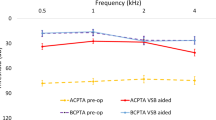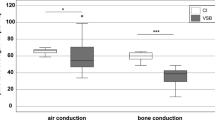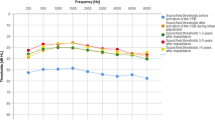Abstract
Objective
This study assessed the safety and sound-localisation ability of the Vibrant Soundbridge (VSB) (Med-EL, Innsbruck, Austria) in patients with unilateral microtia and atresia (MA).
Methods
This was a single-centre retrospective research study. Twelve subjects with unilateral conductive hearing loss (UCHL) caused by ipsilateral MA were recruited, each of whom underwent VSB implantation and auricular reconstruction. The bone-conduction (BC) threshold was measured postoperatively, and the accuracy of sound localisation was evaluated at least 6 months after surgery. Horizontal sound-localisation performance was investigated with the VSB activated and inactivated, at varying sound stimuli levels (65, 70 and 75 dB SPL). Localisation benefit was analysed via the mean absolute error (MAE).
Results
There was no statistical difference in mean BC threshold of impaired ears measured preoperatively and postoperatively. When compared with VSB-inactivated condition, the MAE increased significantly in unilateral MA patients in the VSB-activated condition. Besides, sound-localisation performance worsened remarkably when sound was presented at 70 dB SPL and 75 dB SPL. Regarding the side of signal location, the average MAE with the VSB device was much higher than that without the VSB when sound was from the normal-hearing ear. However, no significant difference was observed when sound was located from the impaired ear.
Conclusion
This study demonstrates that in patients with unilateral MA, the VSB device does not affect inner-ear function. Sound-localisation ability is not improved, but deteriorated at follow-up. Our results suggest that the VSB-aided localisation abilities may be related to the thresholds between the ears, plasticity of auditory system and duration of use of VSB.





Similar content being viewed by others
References
Luquetti DV, Heike CL, Hing AV et al (2012) Microtia: epidemiology and genetics. Am. J. Med. Genet. A 158:124–139. https://doi.org/10.1002/ajmg.a.34352
Alasti F, van Camp G (2009) Genetics of microtia and associated syndromes. J Med Genet 46:361–369. https://doi.org/10.1136/jmg.2008.062158
Abdel-Aziz M (2013) Congenital aural atresia. J Craniofac Surg 24:e418–e422. https://doi.org/10.1097/SCS.0b013e3182942d11
Wang D, Zhao S, Zhang Q et al (2016) Vibrant SoundBridge combined with auricle reconstruction for bilateral congenital aural atresia. Int J Pediatr Otorhinolaryngol 86:240–245. https://doi.org/10.1016/j.ijporl.2016.05.006
Qian J, Li Z, Liu T et al (2017) Auricular reconstruction in hemifacial microsomia with an expanded two-flap method. Plast Reconstr Surg 139:1200–1209. https://doi.org/10.1097/PRS.0000000000003280
Bly RA, Bhrany AD, Murakami CS et al (2016) Microtia reconstruction. Facial Plast Surg Clin North Am 24:577–591. https://doi.org/10.1016/j.fsc.2016.06.011
Leinung M, Zaretsky E, Lange BP et al (2017) Vibrant Soundbridge in preschool children with unilateral aural atresia: acceptance and benefit. Eur Arch Otorhinolaryngol 274:159–165. https://doi.org/10.1007/s00405-016-4265-1
Zahnert T, Mlynski R, Löwenheim H et al (2018) Long-term outcomes of vibroplasty coupler implantations to treat mixed/conductive hearing loss. Audiol Neurotol 23:316–325. https://doi.org/10.1159/000495560
Lailach S, Zahnert T, Maurer J et al (2020) The vibrating ossicular prosthesis in children and adolescents: a retrospective study. Eur Arch Otorhinolaryngol. https://doi.org/10.1007/s00405-019-05667-3
Kumpik DP, King AJ (2019) A review of the effects of unilateral hearing loss on spatial hearing. Hear Res 372:17–28. https://doi.org/10.1016/j.heares.2018.08.003
Brkic FF, Riss D, Auinger A et al (2019) Long-term outcome of hearing rehabilitation with an active middle ear implant. Laryngoscope 129:477–481. https://doi.org/10.1002/lary.27513
Risoud M, Hanson J-N, Gauvrit F et al (2018) Sound source localization. Eur Ann Otorhinolaryngol Head Neck Dis 135:259–264. https://doi.org/10.1016/j.anorl.2018.04.009
Priwin C, Jönsson R, Hultcrantz M et al (2007) BAHA in children and adolescents with unilateral or bilateral conductive hearing loss: a study of outcome. Int J Pediatr Otorhinolaryngol 71:135–145. https://doi.org/10.1016/j.ijporl.2006.09.014
Agterberg MJH, Snik AFM, Hol MKS et al (2011) Improved horizontal directional hearing in bone conduction device users with acquired unilateral conductive hearing loss. J Assoc Res Otolaryngol 12:1–11. https://doi.org/10.1007/s10162-010-0235-2
Vogt K, Frenzel H, Ausili SA et al (2018) Improved directional hearing of children with congenital unilateral conductive hearing loss implanted with an active bone-conduction implant or an active middle ear implant. Hear Res 370:238–247. https://doi.org/10.1016/j.heares.2018.08.006
Thompson NJ, Kane SLG, Corbin NE et al (2019) Spatial hearing as a function of presentation level in moderate-to-severe unilateral conductive hearing loss. Otol Neurotol. https://doi.org/10.1097/MAO.0000000000002475
Nelissen RC, Agterberg MJ, Hol MK et al (2016) Three-year experience with the Sophono in children with congenital conductive unilateral hearing loss: tolerability, audiometry, and sound localization compared to a bone-anchored hearing aid. Eur Arch Otorhinolaryngol 273:3149–3156. https://doi.org/10.1007/s00405-016-3908-6
Vyskocil E, Liepins R, Kaider A et al (2017) Sound localization in patients with congenital unilateral conductive hearing loss with a transcutaneous bone conduction implant. Otol Neurotol 38:318–324. https://doi.org/10.1097/mao.0000000000001328
Koci V, Seebacher J, Weichbold V et al (2016) Improvement of sound source localization abilities in patients bilaterally supplied with active middle ear implants. Acta Otolaryngol 136:692–698. https://doi.org/10.3109/00016489.2016.1155232
Vogt K, Wasmann J-W, John Van Opstal A et al (2020) Contribution of spectral pinna cues for sound localization in children with congenital unilateral conductive hearing loss after hearing rehabilitation. Hear Res. https://doi.org/10.1016/j.heares.2019.107847
Maier H, Baumann U, Baumgartner WD et al (2018) Minimal reporting standards for active middle ear hearing implants. Audiol Neurootol 23:105–115. https://doi.org/10.1159/000490878
Slattery WH, Middlebrooks JC (1994) Monaural sound localization: acute versus chronic unilateral impairment. Hear Res 75:38–46. https://doi.org/10.1016/0378-5955(94)90053-1
Agterberg MJH, Snik AFM, Hol MKS et al (2012) Contribution of monaural and binaural cues to sound localization in listeners with acquired unilateral conductive hearing loss: improved directional hearing with a bone-conduction device. Hear Res 286:9–18. https://doi.org/10.1016/j.heares.2012.02.012
Van Wanrooij MM (2004) Contribution of head shadow and pinna cues to chronic monaural sound localization. J Neurosci 24:4163–4171. https://doi.org/10.1523/jneurosci.0048-04.2004
Webster DB (1983) Auditory neuronal sizes after a unilateral conductive hearing loss. Exp Neurol 79:1–140. https://doi.org/10.1016/0014-4886(83)90384-9
van Wieringen A, Boudewyns A, Sangen A et al (2019) Unilateral congenital hearing loss in children: challenges and potentials. Hear Res 372:29–41. https://doi.org/10.1016/j.heares.2018.01.010
Popescu MV, Polley DB (2010) Monaural deprivation disrupts development of binaural selectivity in auditory midbrain and cortex. Neuron 65:718–731. https://doi.org/10.1016/j.neuron.2010.02.019
Zhuang X, Sun W, Xu-Friedman MA (2017) Changes in properties of auditory nerve synapses following conductive hearing loss. J Neurosci 37:323–332. https://doi.org/10.1523/JNEUROSCI.0523-16.2016
Kesser BW, Krook K, Gray LC (2013) Impact of unilateral conductive hearing loss due to aural atresia on academic performance in children. Laryngoscope 123:2270–2275. https://doi.org/10.1002/lary.24055
Lee MY, Kim DH, Park SK et al (2017) Disappearance of contralateral dominant neural activity of auditory cortex after single-sided deafness in adult rats. Neurosci Lett 657:171–178. https://doi.org/10.1016/j.neulet.2017.08.001
Keating P, King AJ (2013) Developmental plasticity of spatial hearing following asymmetric hearing loss: context-dependent cue integration and its clinical implications. Front Syst Neurosci 7:1–20. https://doi.org/10.3389/fnsys.2013.00123
Lauer AM, Dent ML, Sun W et al (2019) Effects of non-traumatic noise and conductive hearing loss on auditory system function. Neuroscience 407:182–191. https://doi.org/10.1016/j.neuroscience.2019.01.020
Yathiraj A, Vanaja CS (2015) Age related changes in auditory processes in children aged 6 to 10 years. Int J Pediatr Otorhinolaryngol 79:1224–1234. https://doi.org/10.1016/j.ijporl.2015.05.018
Gray L, Kesser B, Cole E (2009) Understanding speech in noise after correction of congenital unilateral aural atresia: effects of age in the emergence of binaural squelch but not in use of head-shadow. Int J Pediatr Otorhinolaryngol 73:1281–1287. https://doi.org/10.1016/j.ijporl.2009.05.024
Asp F, Reinfeldt S (2018) Horizontal sound localisation accuracy in individuals with conductive hearing loss: effect of the bone conduction implant. Int J Audiol 57:657–664. https://doi.org/10.1080/14992027.2018.1470337
Firszt JB, Reeder RM, Dwyer NY et al (2015) Localization training results in individuals with unilateral severe to profound hearing loss. Hear Res 319:48–55. https://doi.org/10.1016/j.heares.2014.11.005
Acknowledgements
This work was supported by grants from Project of Capital Clinical Characteristic Application Research of Beijing Municipal Science and Technology Commission (Z171100001017079) and National Natural Science Foundation of China (No. 81770989).
Author information
Authors and Affiliations
Corresponding author
Ethics declarations
Conflicts of interest
The authors declare no conflicts of interest.
Ethical approval
All procedures performed in present study were in line with the ethical standards. And ethical approvals were obtained from Beijing Tongren Hospital, Capital Medical University, China.
Additional information
Publisher's Note
Springer Nature remains neutral with regard to jurisdictional claims in published maps and institutional affiliations.
Rights and permissions
About this article
Cite this article
Zhao, C., Liu, Y., Yang, J. et al. Sound-localisation performance in patients with congenital unilateral microtia and atresia fitted with an active middle ear implant. Eur Arch Otorhinolaryngol 278, 31–39 (2021). https://doi.org/10.1007/s00405-020-06049-w
Received:
Accepted:
Published:
Issue Date:
DOI: https://doi.org/10.1007/s00405-020-06049-w




